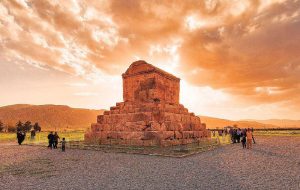No land subsidence detected around tomb of Cyrus the Great, official says
TEHRAN – Mohammad Nasiri-Haqiqat, director of the UNESCO World Heritage site of Pasargadae, has assured the public that no signs of land subsidence have been detected around the tomb of Cyrus the Great. Regular, seasonal monitoring of the land surrounding the ancient site continues to confirm its stability, despite concerns over regional subsidence issues, Mehr


TEHRAN – Mohammad Nasiri-Haqiqat, director of the UNESCO World Heritage site of Pasargadae, has assured the public that no signs of land subsidence have been detected around the tomb of Cyrus the Great.
Regular, seasonal monitoring of the land surrounding the ancient site continues to confirm its stability, despite concerns over regional subsidence issues, Mehr quoted Nasiri-Haqiqat as saying on Monday.
The official addressed the recent reports of land subsidence affecting some heritage sites in the Marvdasht Plain, a region close to both Pasargadae and Persepolis.
He explained that Pasargadae has so far remained unaffected, largely due to the high water table, which is around 60 to 70 meters below the surface in this area. “This higher water level has effectively prevented subsidence in this vicinity,” he noted.
The Pasargadae site undergoes biannual ground-level assessments, and Nasiri-Haqiqat confirmed that no evidence of subsidence has surfaced in these checks, the report said.
Additionally, the official highlighted ongoing restoration work on the tomb of Cyrus the Great, a key part of the site’s preservation plan.
He added that Experts had completed a thorough study and documentation of the tomb’s condition. “Restoration work is currently focused on the northern facade, where conservators are treating cracks and flaking sections to ensure the structure’s longevity.”
Founded in the 6th century BC, Pasargadae was the earliest capital of the Achaemenid (First Persian) Empire. Created by Cyrus the Great with contributions from various peoples of the first great multicultural empire in Western Asia, Pasargadae showcases the initial phase of Achaemenid royal art and architecture. The site’s archaeological remains, including its palaces, garden layout, and the tomb of Cyrus, provide exceptional testimony to Achaemenid civilization.
The 160-hectare archaeological site presents some of the earliest manifestations of Persian art and architecture. Among its monuments are the compact limestone tomb on the Morgab plain that once held Cyrus the Great’s gilded sarcophagus, and Tall-e Takht (“Solomon’s Throne”), a great fortified platform built on a hill later incorporated into a sprawling citadel with substantial mud-brick defenses.
The ancient royal ensemble consists of several palaces originally located within a garden layout, the so-called “Four Gardens.” This design became a prototype for the Persian Garden concept, characterized by four quadrants formally divided by waterways or pathways, with architecture noted for its refined details and slender verticality.
Pasargadae represents the first phase of the development of distinct architectural elements, which later found its full expression in the city of Persepolis.
AM
